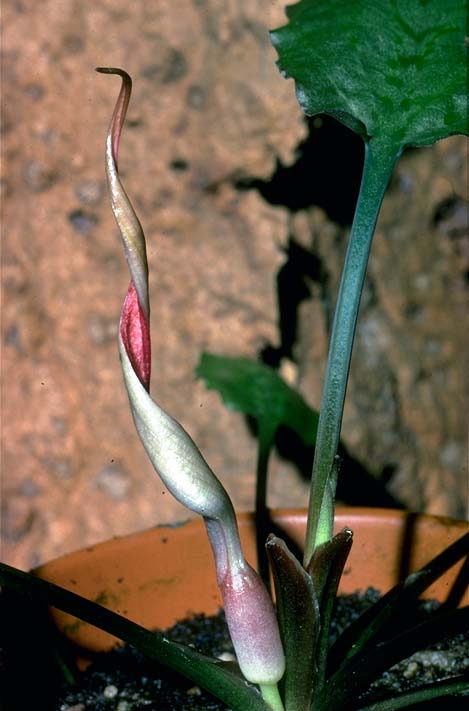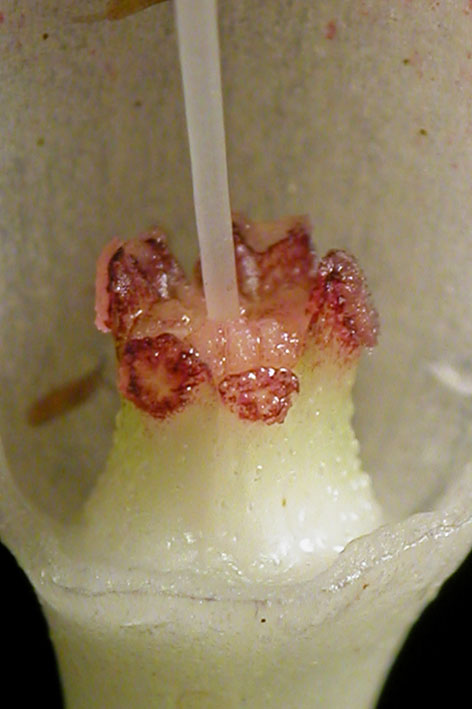| |
Cryptocoryne fusca de Wit |
Cryptocoryne fusca was already in cultivation around 1950 in the Botanical Garden in Bogor under the name C. longicauda ("from Borneo"). Tomey was the first one who found the plant in the Mandor river in West Kalimantan. Now the plant is known from a great part of western Kalimantan, from the tidal zone to deep inland. Recently C. fusca is also found in Sarawak and in Sumatra.
Click on the picture to get the full image (ca. 50 kB) |
 |
Up to the 70's, plants of C. fusca were
regarded to be C. longicauda. When the real identity of the latter was understood
(see De Wit 1953, 1966, 1990), this plant should have a new name: C. fusca.
photo Kebun Rasa Indonesia |
|
 |
Cor Stam making pictures at the Mandor locality where Tomey found the plant.
photo Stam
|
|
 |
After Tomey and Stam, Wongso made several
collections in West Kalimantan. Note the long whitish spathe and the broad, slight bullate
leaves.
coll. SW KB10-P50
photo Wongso |
|
 |
Another collection by Wongso in West Kalimantan.
This specimen has a more brownish limb of the spathe.
coll. SW KB12-P57
photo Wongso
|
|
| |
|
|
|
 |
Ipor found Cryptocoryne fusca in Sarawak, not far from the border with Kalimantan.
coll. NJS 04-16
photo Jacobsen
|
|
 |
C. fusca and C. idei (right) grow in together in the same stream
coll. Bud B-10A
photo Budianto
|
|
 |
Plants from Belitung island, Sumatra, growing half emerged during low water.
coll. YS I-BEST
photo Sasaki
|
|
 |
This plant has rather bullated leaves and a strongly twisted limb of the spathe.
coll. YS I-BEST
photo Sasaki
|
|
| |
|
|
|
 |
Cryptocoryne fusca in emerged culture. The outer
side of the limb is rather pale. The spathe reaches up to 15 cm. Note that the plant is
not so healthy, the leaves are a bit yellowish, probably due to malnutrition.
coll. Tomey s.n., cult. B 330
photo Bastmeijer
|
|
 |
The limb of the spathe in this specimen is not so twisted as
is the plant at left. There are even inflorescence's that don't have a twisted limb, the
opening then is mere a vertical split. Note the transverse stripes on the leaves.
coll. Tomey s.n., cult. B 294
photo Bastmeijer
|
|
 |
C. fusca is not difficult to cultivate. The original
plant in this pot made a couple of runners, flowering at the same time. Note the reverse
twist in the limbs. This is often seen in Cryptocoryne.
coll. Tomey s.n., cult. W 20
photo van Wijngaarden
|
|
 |
A length cut of the spathe of C. fusca. The kettle
and the tube are inside purplish coloured. Be aware that this feature might not be
constant!
coll. Tomey s.n., cult. B 330
photo Bastmeijer
|
|
| |
|
|
|
 |
A very special feature of C. fusca are the hairs on
the lower side and the margin of the leaves. They are ca 0.1 mm, so you'll have to use a
magnificent glass. To see it, just fold a leave and look at the fold. This is also seen in C. ferruginea.
coll. Tomey s.n., cult. B 330
photo Bastmeijer
|
|
 |
The inner surface of the limb is very warty. Though the
surface structure of the inside tube is smooth, there is not a collar in the transition of
the tube towards the limb. Note the 'hairs' on the outer surface of the limb.
coll. Tomey s.n., cult. B 330
photo Bastmeijer
|
|
 |
A less dense coloured limb of the spathe at the transition to the tube.
coll. T&M s.n., cult B 1309
photo Bastmeijer
|
|
 |
The limb of the C. fusca from Sarawak is rather smooth and almost yellow.
coll. and cult. NJS 04-16
photo Jacobsen
|
|
| |
|
|
|
 |
The opened kettle from the Belitung C. fusca with a slight reddish kettle wall. Note also the narrowing in the upper part of the kettle
coll. YS I-BEST, cult B 950
photo Bastmeije
|
|
 |
The female flowers of C. fusca. The styles and the stigma's are a bid reddish. Note the almost white kettle wall.
coll SW09-22, cult B 1325
photo Bastmeijer
|
|
 |
A length cut through the female flowers. Note the ovules in
the opened part,
coll. Tomey s.n., cult. B 330
photo Bastmeijer
|
|
 |
The opened fruit of C. fusca. Imported plants may
have fruits that will ripen in culture. The propagation of crypts by seed is not
a fast way, for most plants make easily a lot of runners, but seeds are also very useful to
start a tissue culture.
coll. Tomey s.n., cult. B 331
photo Bastmeijer
|
|
| |
|
|
|
 |
Drawing of C. fusca in de Wit (1990). Note the hairy
leaves. This feature is seen in elder plants, especially on the lower side.
drawing Ike Zewald
|
|
 |
Drawing in de Wit (1990) of C. tortilis. Differences between this plant and C. fusca are within the variation seen in various
collections.
drawing Ike Zewald
|
|
 |
The known distribution of C. fusca on Beliton island, Sumatra, Indonesia
|
|
 |
The known distribution of C. fusca in Sarawak, West-
and Central- Kalimantan. It grows down to the fresh water tidal zone.
|
|
| |
|
|
|
Cryptocoryne fusca is a nice example of the difficulties in finding the right
trail in taxonomy. When in the 50's, plants from Bogor Botanical Garden, were shipped to
Wageningen University (NL), professor de Wit assumed that it was C.
longicauda. With good reason, for the type material collected by Beccari was
sterile and only a drawing of an unopened spathe exists. In the meantime, plants imported
by Shirley aquatics (UK), proved to be new, and were described by de Wit as C.
tortilis. Then the 'original' C. longicauda was found and thus the Bogor
plant must have a new name: C. fusca. Later on, other botanists declared C.
tortilis and C. fusca as the same species. One might think that the right
name for the species then has to be C. tortilis, but that description was not
valid because of the code, so the name must be Cryptocoryne fusca.
C. fusca is quite easy to cultivate in emerged culture. In the aquarium it is not
an easy plant, but there are many examples of nice cultures.
Updated July 2012 |
Literature.
- Arends, J.C., Bastmeijer, J.D. & Jacobsen, N. 1982. Chromosome
numbers and taxonomy in Cryptocoryne (Araceae).II. Nord.J.Bot. 2 : 453-463.
- Bastmeijer, J.D. & B.H.Bouwmeester. 1992. Cryptocoryne fusca De Wit. DATZ (12) 45 :
788-791.
- Bastmeijer, J.D. 1993. Das Pflanzenportrat: Cryptocoryne fusca De Wit. Aqua-Planta 3-93 :
108-113.
- Ipor, I.B., C.S. Tawan & N. Jacobsen. 2006. Cryptocoryne fusca De Wit (Araceae), a new record for Sarawak. The Sarawak Museum Journal, Vol, LXII, No. 83: 175-184
- Ipor, I.B., C.S. Tawan, J. Abai, N. Saupi & K. Meekiong. 2007/2008. Oekologie und Verbreitung der Cryptocoryne-Arten (Araceae) in Sarawak (Malaysia). Aqua Planta 32(3): 101-106; 32(4): 131-140; 33 (1): 22-27; 33 (2): 48-52
- Jacobsen, N. 1982. Cryptocorynen, Alfred Kernen Verlag, Stuttgart.
- Jacobsen, N. 1985. The Cryptocoryne (Araceae) of Borneo. Nord.J.Bot. 5 : 31-50.
- Kasselmann, C. 1995. Aquarienpflanzen. Ulmer, Stuttgart.
- Paffrath, K. 1974. Cryptocoryne longicauda und Cryptocoryne tortilis. DATZ 27 : 90-92.
- Schulze, J. 1971. Cryptocorynen aus Sarawak I-IV. DATZ 24 : 230-233, 267-270, 303-306.
- Stam, C. 1983. Sungei Mandor, rivier met ruim geschakeerde vispolulatie. Het Aquarium
53(10) : 248-249.
- Wendt, A. 1956. Cryptocoryne longicauda Beccari ex Engler. DATZ 9 : 15-16.
- Wendt, A. 1958. Die Gattung Cryptocoryne Fischer. Die Aquariumpflanzen in Wort und Bild
(1952-1958), Stuttgart.
- Wit, H.C.D.de. 1953. Cryptocoryne longicauda Beccari ex Engler. Het Aquarium 23(11) :
248-250.
- Wit, H.C.D.de. 1953. Description and typification of Cryptocoryne longicauda Becari et
Engler (Arac.). Webbia vol.IX, n.2 : 455-458.
- Wit, H.C.D.de. 1958. Cryptocoryne longicauda. Fishkeeping, dec. 1958 : 710-711.
- Wit, H.C.D.de. 1966. Aquariumplanten, 3e druk. Hollandia, Baarn.
- Wit, H.C.D.de. 1990. Aquarienpflanzen, 2. Auflage. Ulmer, Stuttgart.
|
|
|
|
 |
|
|